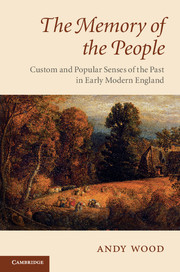Book contents
- Frontmatter
- Dedication
- Contents
- List of figures
- Preface
- List of abbreviations
- Introduction
- 1 Reformation, custom and the end of medieval England
- 2 Custom and popular memory
- 3 Rights, resources and social alignments
- 4 Topographies of remembrance
- 5 Textual and verbal ways of remembering
- 6 The politics of popular memory
- Epilogue.
- Bibliography
- Index
- References
2 - Custom and popular memory
Published online by Cambridge University Press: 05 June 2014
- Frontmatter
- Dedication
- Contents
- List of figures
- Preface
- List of abbreviations
- Introduction
- 1 Reformation, custom and the end of medieval England
- 2 Custom and popular memory
- 3 Rights, resources and social alignments
- 4 Topographies of remembrance
- 5 Textual and verbal ways of remembering
- 6 The politics of popular memory
- Epilogue.
- Bibliography
- Index
- References
Summary
Legal cultures and local cultures
Custom was one of the fundamental, organizing concepts in early modern culture. It was paradigmatic and ubiquitous: as Francis Bacon put it, ‘the predominancy of custom is everywhere visible.’ The English common law was (and remains) a kind of national customary law, amended by statute but with its deep roots in precedent and long usage. In 1612, the Attorney-General for Ireland, Sir John Davies, summarized the customary basis of the common law as follows:
the Common Law of England is nothing else but the Common Custome of the Realm; and a Custome which hath obtained the force of a Law is always said to be Jus non scriptum: for it cannot be made or created either by Charter or by Parliament, which are Acts reduced to writing, and are always matter of Record; but being onely matter of fact, and consisting in use and practice, it can be recorded and registered no-where but in the memory of the people.
Custom, then, was based in collective memory (‘the memory of the people’) and, at least for Davies, originated in oral tradition. This was important for the assertion of customary claims before law courts, giving it a greater force than in Continental Europe, where Roman law operated.
For practical purposes, if claimants to a customary right could show to a law court that the right in question had been exercised continuously since beyond living memory (‘time whereof the memory of man is not to the contrary’ or ‘time out of memory of man’), then they might deem it valid. As Charles Calthorpe put it:
what measure of time shall make a Custome; divers have differed in opinion … But the true measure thereof … is where a Custome or Usage, or other things have beene used, so long as mans memory cannot remember the contrary … And by this it appeareth that Customes, and prescriptions, resteth onely in the memory of man.
Information
- Type
- Chapter
- Information
- The Memory of the PeopleCustom and Popular Senses of the Past in Early Modern England, pp. 94 - 155Publisher: Cambridge University PressPrint publication year: 2013
